|
Power Supply |
Power Supply MkII
kit from
Talking Electronics for $20.00 plus $7.50 postage.
Click HERE
for details.
![]()
This is the cheapest, safest Power Supply you
can get.
It will deliver 0-12v at 1amp and you can limit the current to a few
milliamp so you will not damage a project you are designing.
It has 14v at 5 amp - called an AUXILIARY OUTPUT - that connects directly to
4 cells and you need to be careful as the Li-ion cells are capable of delivering
up to 50 amps if the wires are shorted.
This project is called a BENCH POWER SUPPLY as it is a handy piece of
TEST EQUIPMENT that is designed to deliver a controlled voltage for a
project you are developing.
It is not a continuous power supply as the cells need to be charged (when the
indicator LED does not illuminate).
The Li-ion cells are available on eBay for a few dollars each and you can buy a
single-cell charger for a few dollars. These chargers are microcontroller based
and they stop charging when the cell is fully charged. You cannot charge the
cells from a "battery charger."
You can also get a single-cell charger PCB that connects to your laptop USB
socket and it will charge a cell very quickly. But you will only be able to charge
one cell at a time.
All these things are covered later in the article.
PARTS LIST That's all you need to know. You have the circuit diagram; a photo of the
board and a parts list.
It charges each cell separately and 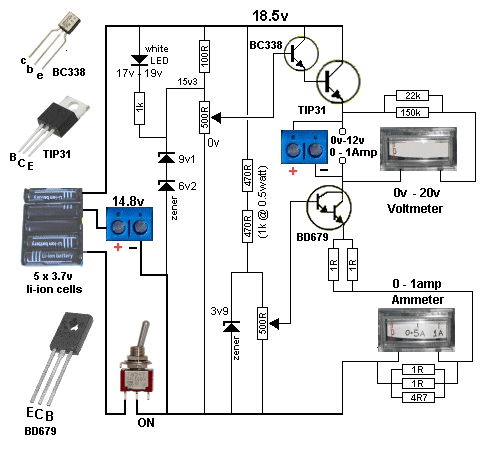
POWER SUPPLY MkII Circuit
You can use 2 x 470R @ 0.25watt or 1 x 1k @
0.5watt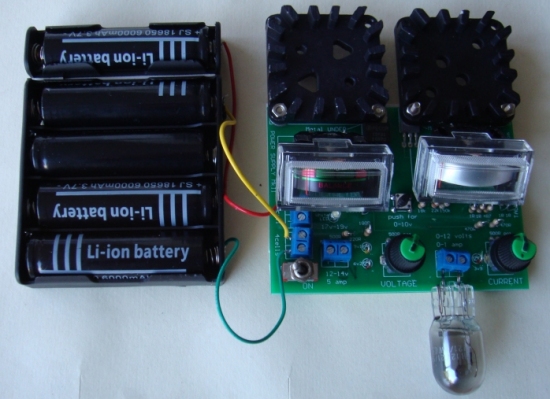
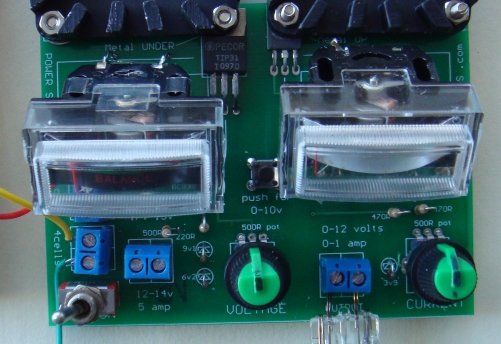
The new PC board uses 1k (in place of 220R shown above as the
current limiting resistor for the white LED) to keep the
brightness low to stop blinding you.
Power Supply MkII
$20.00 plus $7.50 postage.
Click
HERE
for details
4 - 1R 0.25 watt resistors
1 - 4R7
1 - 100R
1 - 220R to be replaced with 1k
(the old board shows 220R - new board uses 1k)
2 - 470R (or use 1k @ 0.5watt resistor)
1 - 1k (as shown in circuit above)
1 - 22k
1 - 150k
2 - 500R trim pots
2 - knobs to suit
1 - 3v9 zener
1 - 6v2 zener
1 - 9v zener
1 - BC338 transistor
1 - TIP31 transistor
1 - BD679 transistor
1 - 3mm white LED
4 - 2-screw terminal blocks
2 - heat fins
4 - sets of nuts and bolts and 5 washers
4 - hook-up wire for battery boxes (to replace
the rubbish on the battery boxes)
2 - side-view panel meters and 2 stickers and
foam tape to hold them in position
1 - toggle switch
10cm 0.5mm tinned copper wire for meters
30cm fine solder
Backing card and 4 feet and foam tape
1 - Power Supply MkII PC Board
Trickle Charger Components are included:
2 - 180R
4 - 3v9 zeners
2 - 9v zeners
3 - 3mm white LEDs
Trickle Charger PCB
Single-cell charger kit $7.00:
1 - USB voltage/current monitor module
1 - single cell charger PC board
1 - single cell battery box
1 - 1R0 5-watt wire wound resistor
These parts are not included in the kit:
5 - 18650 Li-ion cells
1 - 4-cell battery box
1 - single cell battery holder
1 - 4 cell charger
1 - single cell charger
or
USB charger module and single cell battery box
These items can be bought on eBay.
All the components for the board are in the kit and the extra's are: 5 Li-ion
cells, a 4-cell holder and a single cell holder, plus you will need a charger for the cells and these items can be purchased on eBay.
The rest of the article explains how to charge the cells and how to use the
CURRENT LIMITING feature as well as a lot of handy information that will help
you understand how this type of circuit works.
It is not simple to produce a variable power supply with adjustable current and
that's why there are few if any circuits on the web.
This feature is very handy when you are designing a project.
By limiting the current, you can connect a project and if the current is in
excess of the setting, the voltage will reduce and nothing will be damaged. When
the voltage reduces, the current also reduces and this is how you protect the
circuit under test.
HOW TO USE THE CURRENT LIMITING
FEATURE
This is something that has never been explained
before.
To use the current limiting feature, the voltage is turned up a small amount and
then the current limiting knob us turned a small amount so a small voltage will
appear on the output. Now turn the voltage knob to the desired voltage.
Now connect the project to the output terminals and the voltage will possibly
drop to near zero.
Now increase the current until the voltage rises to the
desired voltage.
Read the current and this will let you know the current taken by the project.
While increasing the current you should monitor the ammeter and if it is higher
than expected, you may have a fault in the
project.
CURRENT TAKEN BY A PROJECT
The current taken by a project (the project you connect to this Power
Supply) can be determined by following the
steps described above.
Suppose your project requires 5v and takes 350mA.
Turn the current limiting knob slightly and then turn the voltage knob until the
voltmeter reads 5v.
Connect the project. The voltage will drop to zero.
Now increase the current capability of the power supply by turning the
current-limit knob and as soon as the voltmeter reads 5v, the current taken by
the project can be determined.
If you increase the current-limit knob, the current will not increase because
the Power Supply has indicated the project takes 350mA.
All you are doing is increasing the capability of the power supply to deliver
more current, but the project does not want any more current and it is the
deciding factor.
If the project is a 5v amplifier and takes between 100mA and 430mA, you will
need to increase the current to a maximum of 430mA to allow for the peaks in
current. If you only adjust for 300mA, the voltage will drop during the times
when more than 300mA is requested. The amplifier will not get any more than
300mA and when a higher current would normally flow, the voltage will not drop
to say 4v and the current will not pass 300mA. The result will be some form of
distortion in the output of the audio amplifier.
THE 18650 Li-ion CELLS
We have used five 18650 Li-ion cells for this power supply.
These cells are very cheap on eBay and come in all sorts of capacity. Some start
at 2400mA-hr and others are 12,000mA-hr.
Realistically, you can only allow about 2Amp-Hr and even though some will
take many hours to charge, they will fail in a few minutes when being used.
This is a faulty cell and you will have to throw it out.
The cells shown in the photo say 6000mAh. They were tested and had an
actual capacity of 2,000mA-hr. You cannot believe anything you see on a
battery or cell. It might be true and it might be HYPE.
If
the voltage drops from 19v to about 16v, one of the cells has failed and it will
be quite warm. That's how you can quickly identify a fault cell. Buy a few extra cells to
replace
the faulty ones.
Four cells are held in a 4-cell battery box and one cell in a single cell
holder.
This allows us to provide a 12v (actually 14.8v) output with 5 amp or more
current as a direct output from the auxiliary terminals and 12v with
current limit from the front terminals.
The battery leads, switch and trackwork will "go up in smoke" if a current
higher 10 amps is taken from the 12v - 14v terminals.
CHARGING THE 18650 Li-ion CELLS
Four of the Li-ion cells used in this project can be charged at the same time in
a 4-cell charger, shown in the following picture:
The fifth cell can be charged with a single-cell charger:
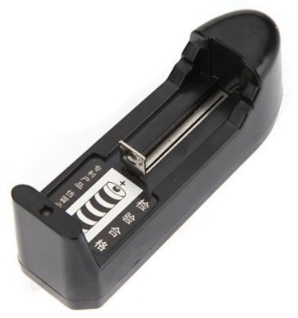
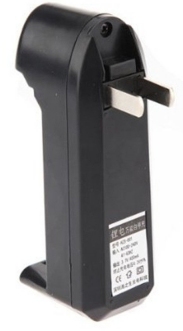
A single cell charger will look something like the images above. It will plug into the wall-socket and charge at about 70mA. These cost less than $2.00 on eBay.
You can also get a 2-cell charger:
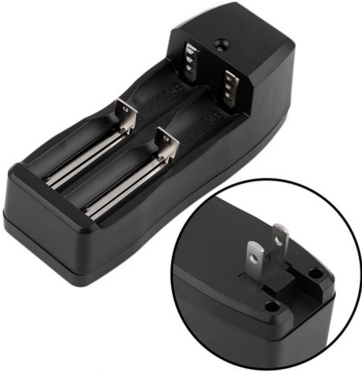
No information is provided for these chargers. We do not know if the charger will charge the cells individually. If one cell is charged, does the charger continue to charge the other cell? What is the charge rate? It will be about 70mA to 100mA but this could be 35mA to 50mA per cell.
Do not buy one of these 4-cell charger modules:
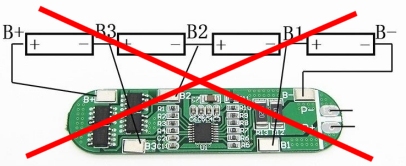
These modules require an input voltage of 18v and a
current up to 4 amps or more.
You will need a 100VA transformer and circuitry to cater for this module. This
is outside the scope of this article.
For a fast charge, you can get a module that
connects to your
USB port will charge at up to 1
amp and you will need to wire it to a single cell holder.
If you want to
charge the cells quickly, you will have to charge them one-at-a-time via the USB
port of your computer.
If you are going to use the project for long periods of time, you will need to
buy 2 sets of cells.
This is the Single-cell charger kit $7.00:
The adapter is connected to a USB monitor module that shows the voltage and
current. It alternated the display automatically every 4 seconds
TRICKLE CHARGING
There are two versions: mini and micro socket - about $1.00 on eBay.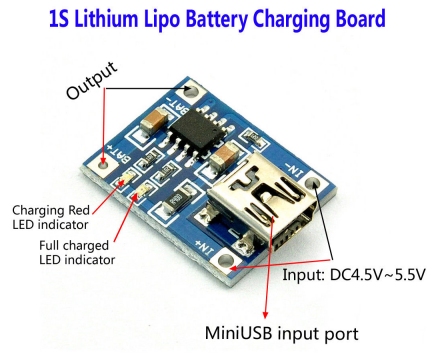
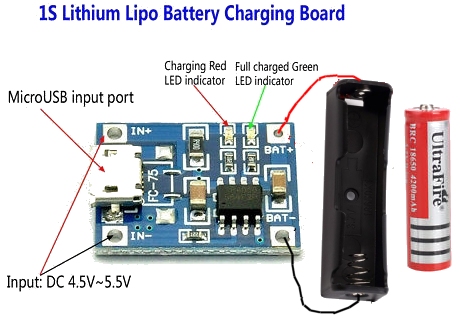
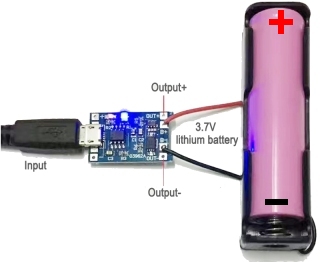
Here is a different charging module but
the hook-up is the same.
This port will only deliver 1 amp and the PCB shown above will take up to 1 amp
during the initial charging of the cell.
The single cell battery box costs about $2.00 on eBay.
You cannot put an ammeter in-line with the Li-ion cell because the
slight voltage-drop across the ammeter will upset the charging. The charger will
think the cells has an extra 0.3v across it and turn OFF !!
The only way to detect the charging-current is to monitor the current entering
the charger.
The following image shows Li-ion charger board connected to an adapter.
1 - USB voltage/current monitor module
1 - single cell charger PC board
1 - single cell battery box
1 - 1R0 5-watt wire wound resistor
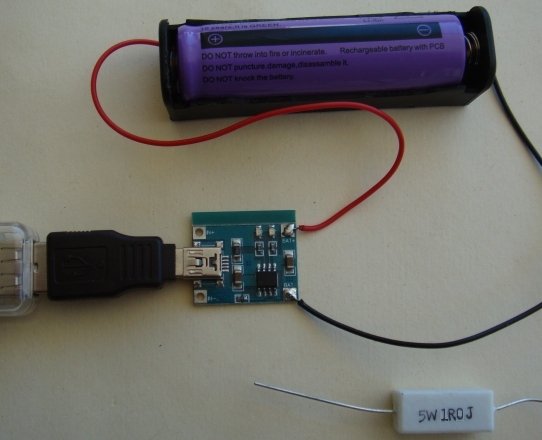
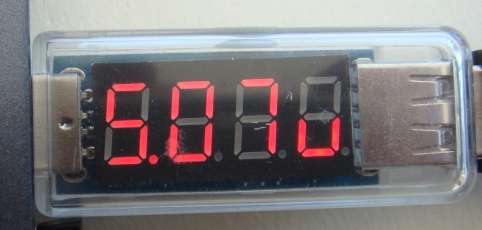
5.07v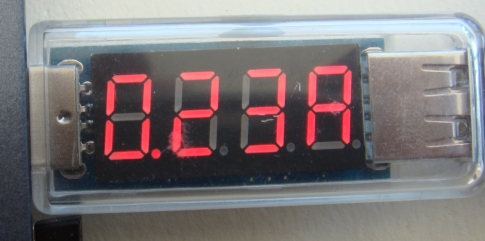
0.23Amps
The current starts at about 230mA and drops slightly as the cell becomes
charged.
Two LEDs on the charger board show RED for "charging" and GREEN for "charged."
The single and double-cell charger supplies about 70mA. The charger board
supplies about 230mA (about 3 times).
The 1R0 5watt resistor is designed to discharge a cell
safely to a minimum voltage of 2.8v.
You need to place a voltmeter across the resistor while discharging to make sure
you do not discharge the cell below its recommended minimum.
The USB voltage-current module and the adapter and Li-ion charger board and 1
cell holder and 1R0 5 watt resistor is available from Talking Electronics for
$7.00 plus postage.
You cannot trickle charge Li-ion cells because they cannot absorb overcharge.
When fully charged, the charge current must be cut off. A continuous trickle
charge would cause plating of metallic lithium and damage the cell.
However the TRICKLE CHARGE circuit we have developed is zener regulated and will
not rise above 20.5v for a 5-cell charger.
This allows 4.1v for each cell and corresponds to 80% charge. We are assuming
each cell will charge at the same rate and produce the same terminal voltage but
the charge-current we are providing is so low that that nothing will overheat or
explode.
The Trickle Charger circuit is designed to be left connected all the time and
will deliver about 500mA-hr to the cells per day, providing the cells are at a
state of discharge.
If they are 70% charged, they will only get an extra 10%.
The circuit is very simple and uses 2 x 12v AC to DC adaptors or a single 24v
adapter. If you supply more than 24v, the 180R current-limiting resistors will
have to be increased.
The circuit will not work with a voltage below 22v.
If the voltage across the 5 cells is 20v, the cells are 75% charged.
If the voltage across the 5 cells is 19v5, the cells are 70% charged.
The charged discussed above will charge the cell to about 95% but if you are
using the project for general-purpose work, the Trickle Charger will be
suitable.
The double-sets of diodes are needed to dissipate the heat. They dissipate the
current from the charger when the cells are charged.
The circuit is designed to deliver a maximum of 50mA and about 35mA goes to the
cells when charging and then the 50mA is passed to the zeners and LEDs when they
are charged. Each LED passes about 15mA, the maximum for a 3mm LED.
When zeners are in a circuit and current is passing through them, the actual
voltage appearing across the zener is higher than the value printed on it.
That's why we have 9v1 and two 3v9 and white LEDs to produce a terminal voltage
of 21v3. It all depends on the current flowing through the zener and the
zener-voltage. About 0.8v is dropped across the signal diode, leaving about 20.5
for charging the cells. All these voltages are heavily dependent on the
manufacturer of the component and the wattage (dissipation) of the component.
That's why we have provided very large lands and tracks on the PC board, to
reduce the temperature-rise of each component.
The tiny zeners are really only about 250mW dissipation, but some manufacturers
allow 400mW and other allow 500mW. We have allowed 250mW and that's why we have
doubled-up the zener strings.
If you are going to use our own zener diodes, you will need to build the circuit
and accurately measure the output voltage with a digital meter before connecting
the Li-ion cells.
The output voltage BEFORE THE CHARGER IS CONNECTED, should be 20v5 to 20v7. This
will prevent the battery being charged above 80%. You cannot measure the output
when the battery is connected as the battery pulls the output voltage down
during the charging process.
|
80% to 90% CHARGED (5 CELLS) = 20.6v to 20.7v |
Once you connect the Trickle Charger, you should read the voltage across the
battery after 12 hours of charging. The prototype measured 20.6v and did not
rise above this value after 2 days. This proves the circuit is working and not
allowing the battery to charge above 20.6v
The Trickle Charger components and PCB are included in the
kit. You need 2 x 12v adapters or a 24v adapter and you can leave the Trickle
Charger connected
and not have to worry about the cells.
000000000000000000000000000000000000000000000000000000000
FREE CELLS
Separate the
cells and keep as much of the tags as possible.
For this project you will need 5 cells. Start by taping 2 cells together with
the positive of one and the negative of the other at one end. Solder the tabs
together.
Now add the 5th cell to the top and tape them all together so they do not move.
HIGH CURRENT
THE SUPPLY
There is one more way to use the Li-ion cells.
CONSTRUCTION
THE SCALES
MOUNTING THE HEAT-FINS
EXPANDED VOLTMETER
It is a voltmeter that shows full voltage for the battery are monitoring and
as the voltage falls 3v, the needle (pointer) moves across the SCALE to ZERO.
You cannot measure the current entering the battery as the leads of the
multimeter will have a resistance within the meter and the charging circuit will
think the battery is 0.2v higher than it actually is. (You will have to study
what I have said . . . to understand it).
This will reduce the charging current considerably and give a false reading.
A battery charged to 80% will still give a short-circuit current of at least 50
amps (that is the full capability of the battery) and you are dealing with a
very dangerous item. A short circuit can create a burnt component and even a
fire, so don't have any paper or cloth anywhere near the Power Supply when you
are not in attendance.
Even a battery at 10% can deliver a high current and melt all the tracks on the
PC board. In fact the tracks are an effective "fuse" and will "go up in smoke"
when a high current flows.
Two wires touched on our prototype and melted the battery box. The smell filled
the house.
That's why we produced a printed circuit aboard and made everything neat and
compact and safe.
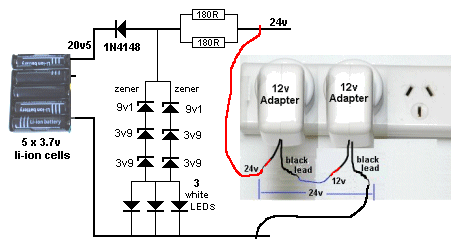
TRICKLE CHARGER CIRCUIT
The 5 cells remain connected to the project ALL THE TIME and you can use it
every day as the charger will charge the cells over-night.
The Trickle Charger will only work with an input voltage of 22v to 24v.
This gives between 1v and 3v "Headroom." If the voltage is below 22v, the
battery will receive NO CHARGE. If the voltage is above 24v, the 180R resistors
will get too hot.
The 5 18650 Li-Ion cells can be obtained from old Lap Top batteries. There are 6
cells in most laptops and generally only 1 or 2 are not able to be charged. When
you take the cover off the cells (by cutting or using a soldering iron to melt a
rectangle on the cover of the cells) you will be able to remove them with the
charging board.
You will not need the charging board as it is specially designed for the Lap
Top.
The good cells will read 4.01v and the faulty cells will read 3.5v. It does not
matter if you cannot determine the fault cells as you will locate them later.
Here is a photo of the 6 cells and charging board:

Now put two cells on top of these with the negative of a top-cell above the
positive of the lower cell. Solder the bottom cell to the top cell. Do the same
with the other.
Now take a reading from the output of the 4 cells. It should be very close to
12.8v. 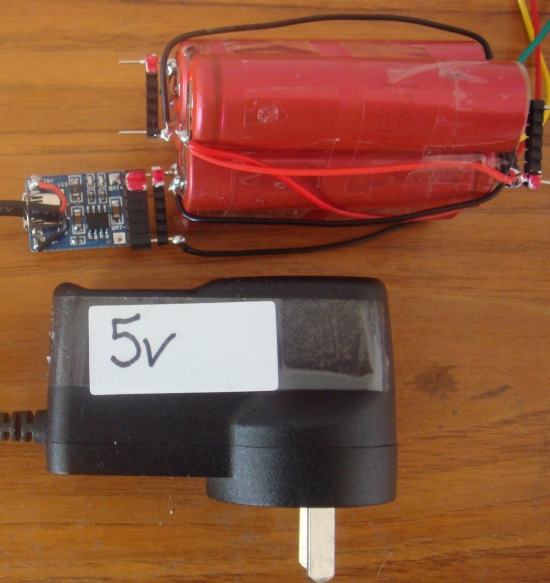
Connect a green wire to the negative terminal, a yellow wire to the 12.8v
terminal and a red wire to the 17v (the top positive terminal). See the
battery box above (connected to the project) for assistance.
Now get a single-cell charger board and solder the leads from a 5v plug
pack to the "+" and "-" terminals on the board. Solder the female plug to the
output of the charger board and make five pin-adapters and solder them to each
cell of the battery pack.
Identify the positive connection.
You will now be able to charge each cell individually with a 1-amp charger
board. It has a red LED to show charging and a blue LED to indicate the cell is
charged.
Make sure the pins all have the positive on the positive on the left-side so the
charger-board can be easily plugged-in.
It will take up to 2 to 3 hours to fully charge each cell and the terminal
voltage will be 4.2v
Make sure the charger is 1 amp or higher as some 1 amp chargers drop to 4.5v
when charging and the cell takes a long time to charge.
You can build another charger-board and charge 2 cells at the same time with two
separate plug-packs because the plug-packs provide isolation.
Having and using a high current power supply
is a very dangerous thing.
Just one cell can deliver a high current and completely melt the battery box.
This has just happened on the workbench and smoke filled the room. The two leads of the 3.7v cell
touched each other and the cell is now too hot to touch and the end of the battery box has
melted onto the bench.
So, it can happen at any time.
That's why you have to be careful and not have any flying leads touching each
other when you are experimenting.
The battery boxes use very thin leads and the ends are poorly terminated. They
fall off very easily.
The first thing you will have to do is replace the thin leads with thicker leads.
These are supplied in the kit and are soldered to the eyelets on the boxes.
Then tape the single box the side of the 4-cell holder to make a 5-cell battery
box.
Connect the 4 leads to the screw terminals provided on the PC board.
Fit the cells ONLY after all the components have been fitted to the board and
the switch is OFF.
TESTING THE PROJECT
Remove the negative wire from the single-cell holder and fit a 12v car globe
between the terminal and negative lead. The car globe needs to be a low wattage
type. Alternatively use one strand of the hook-up wire and push it into the
screw terminals. It will act as a low current fuse.
Click the power switch ON and OFF very quickly.
The globe should not illuminate and the thin wire should not "fuse."
Turn the VOLTAGE and CURRENT knobs fully clockwise and click the power switch ON
and OFF very quickly.
Do a few more test a bit slower and the globe should never illuminate.
Now remove the globe (or wire) and re-fit the negative lead.
Try the ON / OFF switch again and make sure nothing gets hot or starts to smoke.
You have now half-tested the project and confirmed that nothing is shorting or
fitted incorrectly. It's only a preliminary test, but it half-checks everything.
You have to be very careful when you have a high-current available.
Now check the output of the power supply.
Fit a car globe to the output.
Some car globes have a low-wattage filament and a high-wattage filament.
Use the low-wattage.
If you are buying a globe, look for 6 watts to 12 watts. Do not use over 12 watt
globe.
The power supply will not deliver over 1 amp.
It is designed to work up to 1 amp and if the globe starts to take more than 1
amp, (as you turn up the voltage), the voltage will stop at about 8 to 9
volts and the globe will not get very bright.
14 volt OUTPUT
The project has a separate output called
an AUXILIARY OUTPUT that connects directly to 4 cells and delivers a voltage of
about 14v.
There is no current-limiting on this output and if the terminals are shorted, a
very high current will flow.
The PC board has thick tracks to this output but they will only allow 10 amps to
flow and a current in excess of 15 amps will blow the tracks off the board.
If you need 15 amps, you will have to add 0.5mm tinned copper wire under the
board between the battery terminals and the 14v output.
HOW THE CIRCUIT WORKS
The circuit is basically an adjustable power supply with the voltage being
adjusted from 0v to 12v via a pot and the current adjustable from zero to 1 amp.
The only problem with these two features is the need for an input voltage about
4v higher than the output.
The voltage-adjust section of the circuit needs about 2v across the transistor
providing the voltage.
This is only noticed when the output voltage is turned to maximum and then the
drop across the transistor is realised.
The other drop occurs across the current-limiting section and when the current
is a maximum, this drop is only about 2.6 volts with an ideal circuit.
But since we have about 5 to 7 voltage available, we have changed some of the
components in the current-limiting section.
The cheapest way to get a 12v DC supply is with 18650 Li-Ion cells. These
are rated at 3.7v and the makers claim a capacity from 4900mA-Hr to 6,000mA-Hr.
These cells were tested and found to deliver about 1,000mA-Hr to 2,000mA-Hr,
which is way below the stated capacity, but for $2.00, who's complaining?
At $2.00 per cell, they provide the cheapest "high-current" battery on the
market. For short-term requirements, they can deliver 20 to 30 amp, so you are
dealing with a supply that can easily burn-out any normal wiring. So, you have
to be careful not to produce a short-circuit."
You can get single cell holders and multi-cell holders and also single cell
chargers for $2.00, so it's very easy to produce a "battery" - a number of cells
in series and easy to charge them.
The simplest and cheapest way to use these cells to produce a BATTERY is to put
4 in series to get 14.8v
You can put them in single-cell holders or a 4-cell holder.
Charging this type of cell is fairly technical and they should not be
over-charged (in other words, the charging current should be reduced or removed
when the battery is fully charged) or discharged below 2.5v.
But how do you know when the battery is charged?
You can buy single cell chargers for $2.50 and they have a built-in charging
circuit that detects a peak voltage that the cell rises-to when it is fully
charged.
If you buy 1, 2 or 4 chargers for $2.00 each and take the cells out of the
"battery box" and charge them individually, you will be able to charge them
overnight.
The cheap chargers provide a charge current of 80mA to 100mA and it will
take 24 hours to charge the 2A-hr cell.
You can create a 14.8v battery and connect it up to the project.
From the 15v AC of your train transformer, add a 1N4004 power diode and 2 x 47R
resistors in series to the positive of the battery. These components will
deliver about 100mA to the battery and allow you to use the battery for a longer
period of time. Remove the charging when you are not running the trains.
When the cells get to 10v, you will have to put them on the charger.
Work out how much extra time this produced and you may be able to put the two
47R resistors in parallel to increase the time.
But the charging must be removed after running the trains as it will not stop
charging the cells and they will be over-charged.
Finally, another way to get a high current is to combine two power supplies.
Two power supplies can be connected with the two positive leads together and the
two negative leads together.
If they produce exactly the same voltage, the output current will be addition of
each supply.
If the voltages are not equal, the supply with the higher voltage will deliver
more current.
The only way o determine the success of this arrangement is to use each supply
separately and measure the drop in voltage as the current is increased.
Possibly the only way to measure this is to use the THROTTLE and measure
the voltage at full throttle.
Now combine the two power supplies and see the improvement.
Assembly of
the PC board is straightforward.
All the components are clearly marked on the board and it is best to start with
the resistors, then the zeners, transistors, followed by the pots and 2-screw
terminal blocks.
The LED should be soldered so that it is 5mm above the board so the soldering
does not overheat the LED and damage it. Solder only one lead at a time and very
quickly. The LED is very easily damaged.
Make sure you identify the 3v9 as the wrong value will prevent the Power
Supply operating correctly.
The TIP31 is soldered so the numbering on the chip can be seen BUT the BD 679 is
soldered with the metal side of the transistor UP and you cannot see the numbers
on the transistor.
The toggle switch is the last to be fitted. It gets soldered "either way
around."
The two knobs get pushed onto the shafts but first make sure the pot is fully
anti-clockwise and then fit the knob a small amount and turn the pot so that the
pointer moves around from about 7 O'clock to 5 O'clock. Now push the knob onto
the shaft.
If this is not done correctly DO NOT twist the knob into position as you will
The two panel meters are actually 0-1mA MOVEMENTS. This is the
technical name for a coil and pointer BEFORE resistors are added in series or
parallel, to turn the movement into a PANEL METER.
To create your own scale, the clear plastic front is removed by removing the
sticky tape.
The scale is slid out of its grooves and reversed. Push the scale up against a
curved rod of about 30mm diameter and replace it with the blank side showing.
You can fit a white sticker to the scale and add the required numbers.
The voltmeter has series resistors to allow the pointer to read 0v to 12v
and the ammeter has resistors to all the pointer to read 0 to 1Amp.
The two transistors need to be soldered in place and all the other components
should be fitted to the board before attaching the two heat-fins..
Start with the left heat-fin. The transistor will be soldered with TIP31
showing.
Use a short bolt M3x10mm and push it from underside. Fit 2 washers between the
fin and the PC board. Add the
heat-fin and screw on a nut. The other bolt fits up through the hole and through the TIP
transistor. Tighten both slightly and the heat-fin will be parallel to the board.
The second heat-fin uses the longer 16mm bolts and the writing on the BD transistor
cannot be seen as it is against the PC board. Use 3 washers on the 4th
bolt to make the heat-fin sit parallel to the PC board. Don't over-tighten
anything.
When the project is complete and tested, the underside of the board is fitted
with small pieces of double-sided foam tape (supplied in the kit) and then the
thick card is used to cover the board.
4 rubber feet are then added to the corners and the project is complete.
This will prevent wires etc on your workbench touching the underside of the
project and creating a short circuit.
The lamp shown in the photo is 5watt but a 12v 15watt car globe has also been
used for testing the supply and nothing gets hot. The voltage to the 15 watt
globe does not rise above 10v as this is where the globe takes 1amp and that is
the limitation of the power supply.
You can fit the cells under the project or sit the project on the work bench.
The 4 feet and card on the back of the PC board will prevent any short-circuits.
You now have a $40.00 Power Supply that is equal to a $100 supply. And you
built it yourself.
Here's a handy addition you can fit to this project, or any type of battery.

It's a bit like the x5 expansion you get in photography.
In our case, the full scale represents 20.8v and the zero-mark represents about
17v.
The secret is the zener diode (or string of zener diodes) that "absorb" the
first 17v and this voltage does not show on the meter.
It is only the voltage above 17v, that moves the pointer.
So, how do you create an EXPANDED VOLTAGE SCALE.
The mathematics is quite complex. But we will do it without any maths.
You can get any meter (called a MOVEMENT). A Movement does not have any
resistors connected to the terminals.
These resistors may be inside the case and this will be especially true if the
movement is marked "0-100mA" or "0-10v" or "0-1amp"
You do not need to know the SENSITIVITY of the movement as we will be converting
it by EXPERIMENTATION.
If you do know the sensitivity, it might be 30uA FSD. This means it takes
one-third of a milliamp to swing the needle full-scale.
To get you some-where in the picture, this means a 30k resistor in series with
one of the terminals will produce full scale deflection when 1v is applied.
If the movement is 100uA, it will need 10k. If the movement is 1mA, it
will need 1k.
The first thing to do is to connect a number of zener diodes together to get the
"ZENER VOLTAGE." This is the minimum voltage you want to detect.
A zener diode will not drop the exact voltage shown on its body AND the drop
will increase slightly as the voltage of the power supply increases.
That's why this project is not reliable by about 300mV.
But it's the principle that we want to show.
Now, add a 10k resistor to the zener string and connect the movement to the
battery via a switch.
For the first measurement we need the battery to be fully charged.
Turn the project ON and look at the pointer. Increase or decrease the value of
the resistor until the pointer is at FULL SCALE.
Now connect a heavy load to the battery and watch the pointer drop towards zero.
When it is near zero, read the voltage of the power supply.
This is the principle behind an EXPANDED SCALE METER.
You can set the zener voltage to a lower value or a higher value and the meter
will let you know when this percentage of energy has been removed from the
battery.
19-10-2018![]()